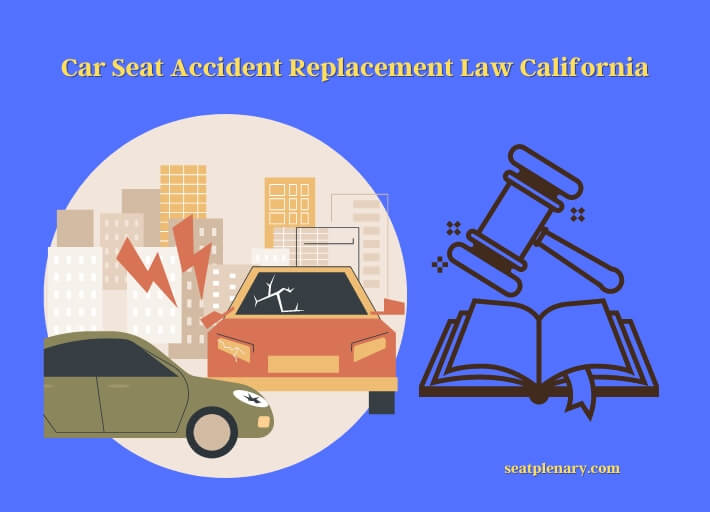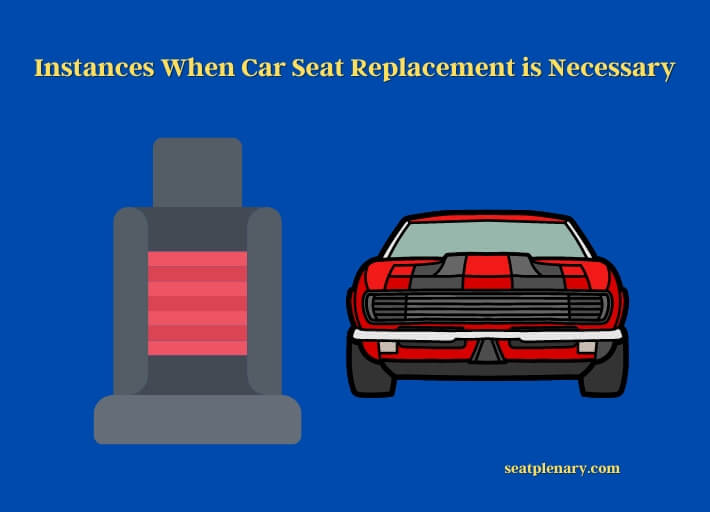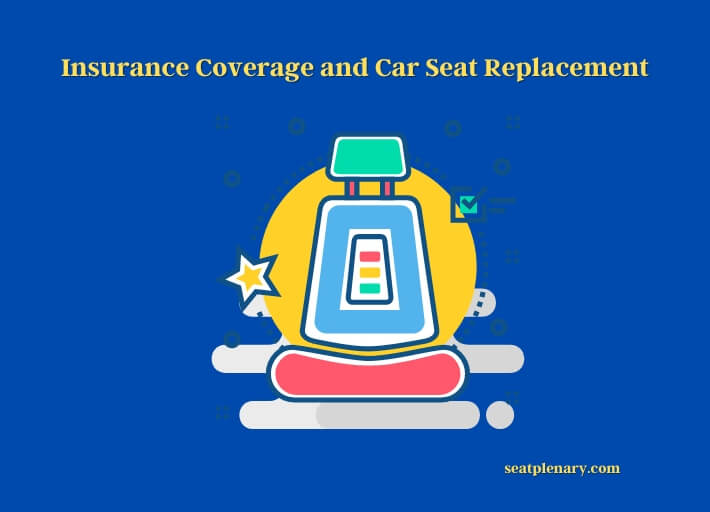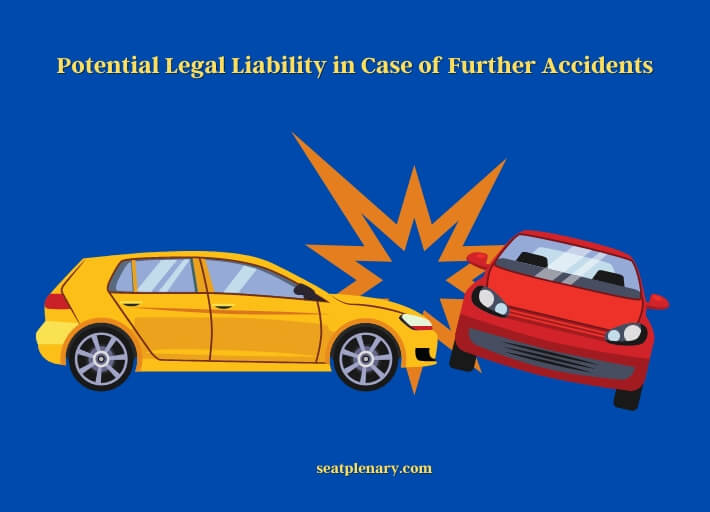Every parent wants the best for their child, and that includes ensuring they’re as safe as possible during every car journey. Car seats are designed to protect your little ones, but their effectiveness can be compromised if they’ve been in an accident.

Understanding car seat accident replacement laws can be daunting, especially when guidelines can vary between states. In this post, we focus on the specifics of California’s regulations, aiming to make them more accessible and easier to understand for all California residents.
Car Seat Accident Replacement Law in California
Navigating California’s Car Seat Accident Replacement Law can be challenging, but with a bit of careful explanation, you can be better equipped to ensure the safety of your child.
Basic Principles and Guidelines
The California Car Seat Accident Replacement Law stresses the paramount importance of child safety. The law operates under the premise that car seats can become less effective in protecting a child after being involved in a car accident. The main principle is that after certain types of accidents, especially moderate to severe ones, a car seat needs to be replaced to guarantee the child’s safety.
A crucial factor here is the severity of the accident. Not all accidents necessitate a car seat replacement. For minor accidents where the car seat shows no visible damage and the child was not in the car seat at the time of the accident, a replacement may not be necessary. However, any doubt about the safety of the car seat should always resolve in favor of the child’s safety.
Differences from Other States’ Laws
It’s important to note that car seat replacement laws can vary significantly from state to state. Some states, for example, do not make a distinction between minor, moderate, and severe accidents. Instead, they recommend car seat replacement after any accident, regardless of severity.
California, on the other hand, has specific guidelines that take into account the nature of the accident when determining whether a car seat should be replaced. This makes the state’s law somewhat more nuanced, but also more flexible.
Regardless of these differences, all states, including California, share the common goal of ensuring child safety in the aftermath of a car accident. So, while the criteria may vary, the ultimate objective remains the same – to protect our children from harm during car travel.
Instances When Car Seat Replacement is Necessary
The replacement of a car seat after an accident isn’t always mandated by California law, but there are specific instances where it’s considered crucial. Understanding these instances will help ensure that your child remains safe during your daily commute or longer journeys.

Minor, Moderate, and Severe Accidents: Distinctions and Implications
California law differentiates between minor, moderate, and severe car accidents when it comes to car seat replacement. Here’s what you need to know:
Minor Accidents:
After a minor accident, car seat replacement isn’t necessarily required. A minor accident is one where the vehicle can be driven away from the accident scene, the vehicle door closest to the car seat isn’t damaged, no one in the vehicle is injured, airbags didn’t deploy, and there’s no visible damage to the car seat.
Moderate or Severe Accidents:
If the accident is moderate or severe—where there’s significant vehicle damage, injuries, or airbag deployment—replacement of the car seat is a must. These more serious accidents can compromise the integrity of the car seat, making it less effective in the event of another collision.
Replacement After a Car Theft or Break-In
Another instance when you should replace your car seat is if your vehicle has been stolen or broken into. Even if there’s no apparent damage, the car seat might have been tampered with or subjected to conditions that could weaken its structure or functioning. It’s always safer to replace the car seat in these circumstances to ensure maximum protection for your child.
In all of these situations, the replacement rule is centered around a ‘better safe than sorry’ approach. If there’s any doubt about whether a car seat should be replaced, it’s best to err on the side of caution. After all, your child’s safety is the highest priority.
Deciphering The Different Severity Levels
Car accidents can vary greatly in their severity, and understanding these differences can be key to determining whether your child’s car seat needs to be replaced. Here, we break down the different severity levels of car accidents as they pertain to California’s Car Seat Accident Replacement Law.
Evaluating Car Accident Severity: A Step-by-Step Guide
The severity of a car accident is generally determined by several factors:
Airbag Deployment:
If the airbags were deployed during the accident, it’s usually considered a clear sign of a moderate to severe accident.
Vehicle Damage:
The extent of vehicle damage also helps gauge the severity. If there’s substantial damage that requires the car to be towed, it’s likely a moderate to severe accident.
Injuries:
The presence of injuries immediately escalates the accident to a more serious level. Any injuries to passengers, especially to children, should prompt a car seat replacement.
Minor Accidents and Car Seat Replacement: When it’s Essential
Under California law, a minor accident is one where the vehicle can be driven away from the scene, no injuries occurred, the airbags did not deploy, and the car seat appears undamaged. However, even in minor accidents, if the car seat is visibly damaged or the child was in the seat at the time of the accident, replacement becomes essential. Any cracks, fraying, or deformities on the car seat should be seen as red flags.
Major Accidents: The Mandatory Replacement Rule
In the case of major accidents, the law mandates the replacement of car seats. Major accidents typically involve significant vehicle damage, the deployment of airbags, or injuries to passengers. After such an accident, unseen damage to the car seat can compromise its ability to protect a child in subsequent accidents.
The bottom line here is that car accident severity plays a vital role in determining whether your car seat needs to be replaced. Understanding these severity levels can help ensure that you’re keeping your child safe during every car journey.
The Manufacturer’s Role in Car Seat Replacement
Car seat manufacturers play an essential role in maintaining child safety. They not only provide the car seats themselves but also offer important guidelines on when to replace a car seat after an accident.
Manufacturer Guidelines for Car Seat Replacement
Each car seat manufacturer sets its own guidelines for car seat replacement after an accident. These guidelines are usually available in the car seat manual or on the manufacturer’s website. Some manufacturers recommend replacing the car seat after any accident, regardless of severity, while others might align more closely with the California law’s specifications.
It’s crucial to review these guidelines and follow them in addition to the law. Your car seat’s warranty could be invalidated if the manufacturer’s guidelines aren’t followed, leaving you without coverage if the seat fails to perform correctly.
How to Contact Your Manufacturer and What to Ask
If you can’t find information online or in your manual, it’s recommended to contact your car seat manufacturer directly. Most manufacturers have customer service lines or email addresses for inquiries.
When contacting them, you should ask about their specific car seat replacement guidelines after an accident. This includes asking about different accident severity levels and how they define them.
Additionally, inquire if the manufacturer offers any replacement programs or discounts. Some manufacturers might provide replacement car seats at a reduced cost or even free of charge in certain circumstances.
In essence, understanding your car seat manufacturer’s guidelines is just as important as understanding California’s Car Seat Accident Replacement Law. Both provide crucial guidance designed to protect your child in the event of a car accident.
Insurance Coverage and Car Seat Replacement
Understanding your auto insurance policy and its provisions regarding car seat replacement is crucial, as it can greatly assist in covering the costs associated with replacing a car seat after an accident.

Understanding Your Auto Insurance Policy: Does it Cover Car Seat Replacement?
Many auto insurance policies include provisions for child safety seat replacement after an accident. These are typically under the personal property or collision coverage portions of your policy. However, the specifics can vary widely, depending on your provider and the details of your policy. It’s important to read your policy carefully or contact your insurance agent to confirm whether car seat replacement is covered.
Filing a Claim for Car Seat Replacement: A Detailed Walkthrough
If your insurance policy does cover car seat replacement, you should know how to file a claim correctly to ensure a smooth process. Here are some steps to consider:
Document the Accident:
This includes taking photos of the accident scene, the damaged vehicle, and the car seat. You should also keep a copy of the police report, if available.
Contact Your Insurance Provider:
Reach out to your insurance provider as soon as possible after the accident to report the incident and start the claims process.
Provide Required Information:
Your insurance company will likely need specific information about the accident, the car seat, and any related costs. This could include the car seat’s make, model, and age, as well as receipts for the replacement car seat, if already purchased.
Follow the Claims Process:
Each insurance company has its own claims process. It’s essential to follow the process as directed by your insurance company to ensure the claim is handled correctly and efficiently.
Remember, every insurance policy is different, and not all policies will cover car seat replacement. Knowing your policy and the proper procedures for filing a claim will put you in a strong position to navigate the process if you find yourself needing to replace a car seat after an accident.
The Role of Car Seat Expiry Dates in Replacement
Car seats aren’t designed to last forever. They come with expiry dates set by the manufacturer, usually ranging from six to ten years from the production date. Understanding the role of these expiry dates in car seat replacement can help ensure the safety of your child.
Why Do Car Seats Expire?
Car seats expire for several reasons:
- Wear and Tear: Over time, the car seat materials can degrade, which might compromise their performance in a car accident.
- Technological Advances: Safety standards and technologies continually evolve. A car seat that was top-of-the-line a few years ago might not meet current safety standards.
- Missing Parts and Manuals: As car seats age, they might lose parts, or the instructions may become misplaced, leading to improper use.
Finding the Expiry Date on Your Car Seat
The expiry date of a car seat is usually printed on a label attached to the seat, or it may be imprinted directly into the plastic. If you can’t find it, consult the car seat manual or contact the manufacturer.
Car Seat Replacement: When the Expiry Date Comes Into Play
If your car seat is close to its expiry date or already expired, it should be replaced, regardless of whether it was involved in an accident. An expired car seat might not provide the protection your child needs in a crash.
Furthermore, if your car seat is involved in an accident and it’s close to the expiry date, it might be more cost-effective and safer to replace it, even if the accident was minor.
In summary, always be aware of your car seat’s expiry date. Using an expired car seat can put your child at risk, and being aware of the date can also assist you in making decisions about replacement after an accident.
Steps to Properly Replace a Car Seat After an Accident
After a car accident, you might be required to replace your child’s car seat. It’s a process that needs careful attention to ensure the safety of your child. Here are the key steps to follow:
Document the Accident and Car Seat
Before disposing of your damaged car seat, document the condition of the car seat with photos or videos. This can be crucial if you need to file a claim with your insurance company or report the issue to the manufacturer.
Dispose of the Damaged Car Seat
Once you’ve documented its condition, it’s time to dispose of the damaged car seat. But don’t just throw it away. You want to ensure that the seat isn’t reused by someone else who might not realize it’s been compromised.
You can cut the straps or write ‘DO NOT USE’ on the seat. Some local recycling centers might also accept car seats.
Select a New Car Seat
Select a new car seat that fits your child’s current age, weight, and height, and also fits well in your vehicle. Check the latest safety standards and read product reviews to ensure you’re choosing a highly-rated model.
Install the New Car Seat Correctly
Car seats can only offer maximum protection when they’re installed correctly. Read the manufacturer’s instructions carefully and ensure the seat is tightly secured in your vehicle. If you have any doubts about the installation, consider getting professional help. Many local fire departments, police stations, and hospitals offer car seat inspection and installation services.
Register Your New Car Seat
Finally, remember to register your new car seat with the manufacturer. This is an important step because if there are any recalls or safety notices in the future, the manufacturer can contact you directly.
By following these steps, you can ensure the correct, safe, and efficient replacement of your car seat after an accident, giving you peace of mind about your child’s safety during car travels.
The Legal Consequences of Non-Compliance
Non-compliance with California’s Car Seat Accident Replacement Law can lead to legal consequences. It’s important to understand what these are, not just to avoid penalties, but more importantly, to protect the safety and well-being of your child.
Traffic Violations and Fines
Failure to replace a car seat after a serious accident could result in a traffic violation under California law. If a law enforcement officer discovers that a child is riding in a car seat that should have been replaced due to an earlier accident, the driver could be issued a ticket. This could result in a fine, which varies depending on local laws and the specifics of the situation.
Potential Legal Liability in Case of Further Accidents
If a child is injured in a subsequent accident and it’s discovered that the child was riding in a car seat that should have been replaced, the driver could potentially face legal liability. This could include personal injury lawsuits brought by the child’s other parent or guardian. In these cases, the fact that the driver failed to replace the car seat could be used as evidence of negligence.

Impact on Insurance Claims
Failure to replace a car seat after an accident could also have implications for any insurance claims related to a subsequent accident. An insurance company might deny a claim if they find that the driver was using a car seat that should have been replaced after a previous accident.
In conclusion, the legal consequences of failing to replace a car seat when necessary extend beyond fines and traffic tickets. They can lead to significant legal liability and problems with insurance claims. However, the most crucial consequence is the potential risk to the child’s safety, making compliance with the law both a legal and a moral imperative.
Some Resources for Car Seat Accident Replacement in California
Insurance Cover Car Seat Replacement – Progressive: Progressive is known to provide car seat replacement if it’s damaged in an accident. This coverage is part of their auto insurance policy. If you’re insured by Progressive, it’s best to contact your representative for detailed information on the claims process and eligibility requirements.
NHTSA Car Seat Inspection Center: The National Highway Traffic Safety Administration (NHTSA) operates numerous inspection centers throughout California. These centers can assess the condition of your car seat after an accident, and provide necessary guidance on whether it needs to be replaced.
Who’s Got Car Seats – California Office of Traffic Safety – CA.gov: The California Office of Traffic Safety runs an initiative named “Who’s Got Car Seats”, providing resources to assist parents with car seat safety. It’s an invaluable resource for understanding car seat requirements and getting assistance after a car seat accident.
Child Passenger Safety (CPS) Laws and Regulations – CDPH: The California Department of Public Health (CDPH) provides comprehensive information on CPS laws and regulations. Knowledge of these laws will help you understand your rights and responsibilities when it comes to car seat safety.Car Seat Recycling Program by Yolo County: If your car seat is deemed unfit for use after an accident, Yolo County’s recycling program ensures that the seat doesn’t end up in a landfill. The program accepts all types of car seats, facilitating eco-friendly disposal.
Frequently Asked Questions (FAQs)
What should I do with my car seat immediately after an accident?
If your car seat was in an accident, you should stop using it until you can determine whether it needs replacement according to the severity of the accident and any visible damage.
How Does Flexible Seating Impact Child Safety in Cars?
When considering child safety in cars, student success through flexible seating is a top priority. The ability to adjust seats to fit children’s size and weight ensures maximum safety in case of an accident. Flexible seating options also allow for proper installation of car seats, reducing the risk of injury during travel.
How can I tell if my car accident qualifies as ‘minor’ or ‘moderate’ under California law?
Generally, a minor accident involves situations where the vehicle can be driven away from the scene, no injuries occur, airbags do not deploy, and there’s only minor damage. Moderate or severe accidents usually involve significant vehicle damage, injury, or airbag deployment.
Is it legal to use a second-hand car seat in California?
Yes, but it’s recommended that you know the seat’s full history, including whether it’s been in any accidents. You should also check the expiry date and whether the model has been recalled.
How does the law apply to out-of-state visitors involved in a car accident in California?
The same rules apply. If you’re in a moderate or severe accident while visiting California, you should replace your car seat and cover.
What if my insurance company refuses to cover the cost of car seat replacement?
If your insurance policy covers car seat replacement and the company refuses to pay, consider reaching out to your state’s department of insurance or a legal advisor. Always read your policy carefully to understand what is covered.
Conclusion
California’s car seat accident replacement law exists to protect your children. Ignoring these laws risks their safety and could have legal ramifications. It’s crucial to replace your car seat after a moderate or severe accident, or a minor one if there’s visible damage or your child was in the seat at the time.
Stay informed about the laws governing car seat replacement. Understand your auto insurance policy, keep track of your car seat’s expiry date, and always follow manufacturer guidelines in addition to the law.
Read more:
